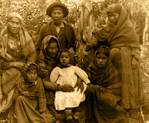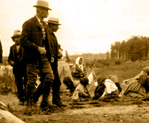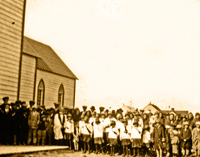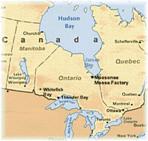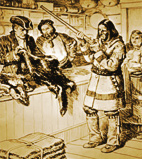Chapter 4A - 1
Treaty No.Nine : The James Bay Treaty
I want to ask you a question: what is a treaty? If you don't know don't worry. I didn't either when I was in high school in the late 1970s. Many teachers asked me what Treaty No. Nine was during my high school years but I could not explain it to them. However, since then I think I've learned a few things about it. Anyway before we talk about Treaty No. Nine, a few definitions and explanations are useful.
In my mind, a treaty is an agreement that is made between two parties. The parties could be two individuals, a group of people, a company, or perhaps, two governments. Treaties are a way to explain how parties intend to “treat” each other for the duration of a relationship. Before a treaty is signed both parties must negotiate (discuss) what will be the intent of the treaty. When parties negotiate they speak and listen to each other's concerns and eventually come to a decision that both parties agree to. Ideally, treaty discussions and negotiations occur first before any written documents are produced. Each party has to be sure that they understand exactly what they're agreeing to before they sign anything. Each party must be sure that the terms, benefits, extent, limitations and the binding nature of the agreement are exactly what they have been discussing. If a rough agreement is written and you notice that sections are written, changed, added or deleted without your input then it is a good indication that you should not sign but raise your concern! However, if an agreement is accurate and clear, then you will feel confident in signing because it reflects your interests. As well, you will feel that the other party, as you are too, will be bound to act in good faith, trust and sincerity in performing the duties as set out in the agreement. That was pretty easy wasn't it? Well, sometimes life does not always turn out that way.
Chapter 3
Where are the animals? Who will help us?
As I mentioned earlier, since 1670, our peoples began a 300-year economic relationship with the Hudson's Bay Company fur trade in the James Bay region. We became the experts who lived deep inland during the winter months, trapped and brought in many beaver pelts to the coastal posts during the summers. At first life was good for our peoples as trappers saw the rewards of their labours and the new technology offered by the Europeans. Instead of bow and arrows we now traded for steel guns. Instead of wooden deadfall traps, we now acquired steel traps. We also traded our furs for steel pots, pans, knives, axes and other utensils. We even watched the Europeans dance to fiddle tunes and we liked it so much that we learned their dances and songs on fiddles of our own. We even incorporated foods of the Europeans like bannock, tea, sugar and lard into our traditional diets.
But somewhere along the way, this all changed and it was in the years 1850 to the early 1900s. Although peoples had experienced sickness before, in this time period our peoples again became infected with European diseases like whooping cough, measles and influenza. It was hard when people got sick because many of them were far from the settlements where medicine and skilled medical assistants might help them.
"One time there was a family who lived in a tent when it was very cold. The parents died and only the children survived. That was when there was a great sickness. Both the parents died, both the father and the mother. One child died as well. Only a girl, a boy, and a baby survived. They were far from the reserve. They took the baby and started to walk. We do not know how many days and nights they walked. All of them managed to get to the settlement. Those children whose parents died were very poor" (Elder Gabriel Kam in Ojibway Cree Cultural Centre 1999: 25-26).
Many of our people also had a lot of trouble finding animals to trap and hunt for food. Something was happening on the land with the animal populations that made finding them extremely difficult. Often they could only find small game like rabbits, ptarmingan and fish. So many people died of starvation. Our Elders tell many stories of hunting hardships and of those who perished from hunger. My own mother who was a young child in the early 1900s told me that often the only food they could depend on was fish. She ate fish everyday with small portions of bannock and tea.
My mother's family (five siblings) often didn't eat until her mother could check the nets in the morning. My mother says that people today do not understand the difficult times she and others went through (Elder Agnes Louttit 2008: personal communication). You will see what I mean by reading the following Elder narratives:
"I saw the people of one family starve to death. We were not living very far away. They did not have anything to eat while they were traveling. Five of them froze to death on their return because they collapsed due to hunger. One woman had a child she was carrying in a tikinagan. That child died because the mother could not produce milk due to a lack of food" (Elder Juilette Sutherland in OJCC 1999:68).
"They traveled two days without having anything to eat. They were almost near the village when his stepson told him that the family could not travel any further. It was very cold. According to the old man, they immediately tried to go ashore. He said the younger woman was the first to collapse. Some died in that shelter as night was approaching" (Elder Nancy Patrick in Ojibway Cree Cultural Centre 1999: 40).
"That is how poor we were during our childhood. We almost starved then. We could not even catch fish in the net. We had nothing to live on when we were camping there. All we did was fish for pike. That is what we ate" (Elder Ellen Sainnawap in Ojibway Cree Cultural Centre 1999: 9)."When I was young, I saw many people who had nothing to eat. Once, two starving adults and two starving children were brought to the place where we were living. Two other children from that family had died earlier. This hungry family survived by eating small fish that surfaced on a little creek. This family stayed with us for about one week" (Elder Agnes Nakogee in Ojibway Cree Cultural Centre 1999: 31-32).
There are many other narratives about sickness, starvation and poverty but the ones I've shown you I think are sufficient. My point is that I would like you to know that by the beginning of the 20th century many of the people were poor, starving and ill from sickness. And in this condition many of our people were destitute and distressed about what would happen to them and their children. They despaired over why the animals had seemingly abandoned them.
As well, many people lost faith in our ways and set aside their traditional beliefs for the Christian faith.
It was at this time that many people heard stories of other peoples to the south who were signing treaties for money, medicine, schools and relief as a means to help them survive.
Our Elders, parents and village leaders were thinking of the future for their communities, families and children.
What would they have? What could they do now to improve their situation? So it was in this way that our peoples sought to make a treaty with the governments of the day.
Story Introduction
Well, my name is Stan Louttit; I’m a writer and researcher I have lived all my life in the small, island community of Moose Factory, at the bottom tip of James Bay, in Northern Ontario.
My father was a Mushkegowuk (Western James Bay Cree) person from the Albany Band (now the Fort Albany First Nation), Northwestern Ontario and my mother is from the Eeyou (Eastern James Bay Cree) Nation of Eastmain, Northern Quebec.
In this way, I am both a Muskegowuk and Eeyou person who has family roots on both the Western and Eastern shores of James Bay. My grandfather was Mushkegowuk but also had Scottish blood. He came from a long line of Scottish/Mushkegowuk "mixed bloods", like his father, and his grandfather, who worked for the Hudson’s Bay Company (HBC) fur traders. Men like my grandfather and other Mushkegowuk/Scottish Cree worked as post hunters, mail deliverers, clerks, blacksmiths, coopers, carpenters, or as general laborers for the HBC fur traders. Indeed, my grandfather himself was a cooper, but also a translator, fur grader and general store clerk who like many Company men before him married a Mushkegowuk woman.
At the time of the treaty signing in 1905, my grandfather, who was probably known as a "mixed blood" locally, was signed into and included in the James Bay Treaty list of Indians at Albany (HBC post). My father explained once that because my grandfather was a Company servant, married to a Mushkegowuk woman, followed the traditions and spoke the Mushkegowuk language, he was likely considered important by the Albany Indian headmen (leaders). So, at the treaty signing, important Albany headmen to the Treaty may have wanted certain "mixed blood" families such as my grandfather’s family, to be included under Treaty No. Nine. Thus, my grandfather’s family was listed, like others, at Albany, to receive treaty and to benefit from its terms (Long 185: 143).
Before sharing with you the oral understanding and the Mushkegowuk perspective on Treaty No. Nine, I would like to give you a sense of who the Mushkegowuk and Anishiinawbe Peoples were in 1905 and how they got to be in the position they were in at that time in our history.
Chapter 2
Others Among Us
In the 1600s, in James Bay, my ancestors encountered others on the land. These people spoke a different language, looked different and wanted the furs we used for clothing. We now know these strangers to be Hudson Bay Company servants and explorers that traveled in tall, wooden ships from England to our lands in search of furs for European felt hats. We even have a Mushkegowuk word, Wemistukuushuu to describe the Europeans. This is an old word that refers to people whose shoes are made of wood. Some of our peoples also believe the word refers to a floating island with a tall post in the middle (tall ships). To make a long story short, in 1670, we began 300 years of trade, servitude, allegiance, respect and inter-marriage with the people of wooden shoes.
However, from our stories, we also know that our peoples may have known of and traded with others long before we met the Europeans. Our stories speak of Natoowaywuk (Iroquois peoples) who were fierce and in some of our stories they came into our lands on raiding trips. A lot of us today also believe that we may have traded with other southern First Nation peoples (Algonquins) long before the Europeans traded with us. So in this way, trade, business, respect and yes, conflict with others was not something new to us.
Because of our prior experience in trading and bargaining for furs, pottery, wooden utensils and other objects, trading with the Hudson Bay Company people was easy. We engaged in the fur trade with them. We even hunted geese, ducks, caribou and harvested other food such as fish to help the Hudson Bay Posts survive in our harsh environments.
In many instances, the Hudson Bay Company and the fur trade would not have survived without our knowledge of the land, animals and climate in the James Bay region.
Now I want to give you information that will be very important for your understanding and knowledge concerning my peoples in the fur trade. It is extremely important for you to know how we dealt, traded and bargained with others. You see the basis of trade relations were based on trust and good faith in our dealings with the Hudson’s Bay Company. Our philosophies were built on how we saw ourselves interacting with other First Peoples, the land and animals. The idea is a simple one and lies at the heart of how we respect others such as the land, animals, the spirits and humans.
You see the fundamental principles or laws that we follow came from the land and animals. The animals, fish and birds gave themselves to us but expected us to acknowledge, respect and honor those who had given life so that we may live. It is an intimate relationship of respect, love, trust and caring. Our ancestors believed that we must always show respect, love, trust and caring to the animals we harvest for food. Our rituals were directed to them. Some rituals involved offering tobacco to the water, placing meat in the fire and singing hunting songs that were devoted to the animal spirits that gave their lives to us. The songs and the way the hunter sang of the beaver, caribou, moose, geese or fish acknowledged and nurtured this special relationship with his hunting spirit as well as to the animal and earth spirits. This relationship was so important to cultivate because if we didn’t follow these protocols of respect in honoring the hunting, animal and earth spirits, they would be offended and disrespected. Consequently, the spirits would feel our dishonor, irresponsibility and selfishness and could make hunting very hard for us. The result would be that the animals would not show themselves to us.
Thus, our adiucan (ancient myths) and tipachimowin (recent stories) have themes that tell of the way we should act properly towards animals and food. The underlying themes speak of how we should act ethically. How we should follow the principles of reciprocity; to take but give back in exchange. The adiucan and tipachimowin portray what happens to irresponsible individuals who disregard the norms and values of our society, land and animals. Irresponsible characters in ancient adiucans eventually die shamefully from their actions. For example, the adiucan of Ayash, an evil, jealous leader who behaves badly and acts selfishly, shows what happens to persons that act anti-socially, unethically and irresponsibly. In essence, that story and others like it reveal what happens to the good and what happens to the bad. The stories are a guide to teach conscientious individuality, serving as a form of social control, and to develop competent behavior. These are the essential themes and truths of our stories and the way life is in our worldview.









